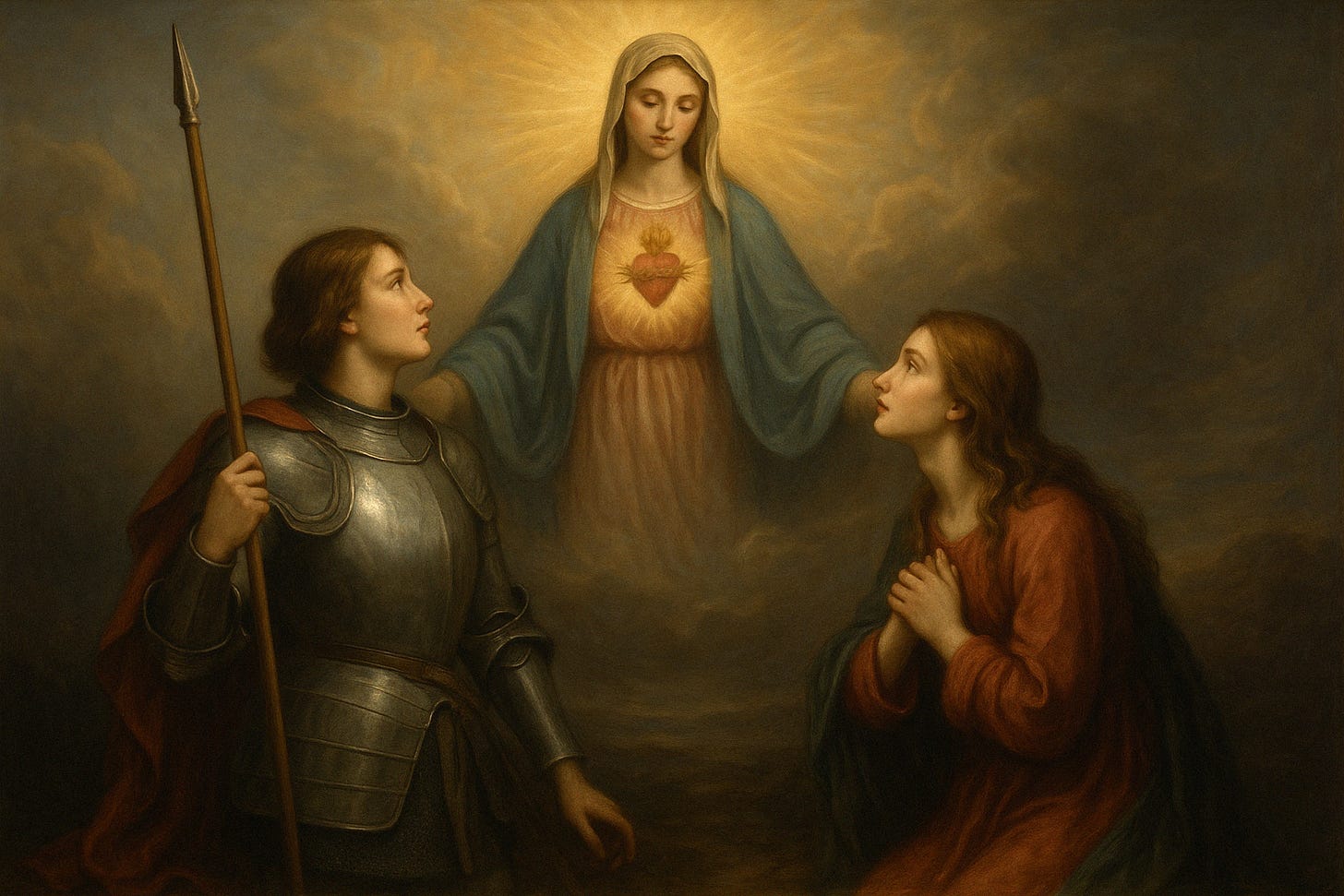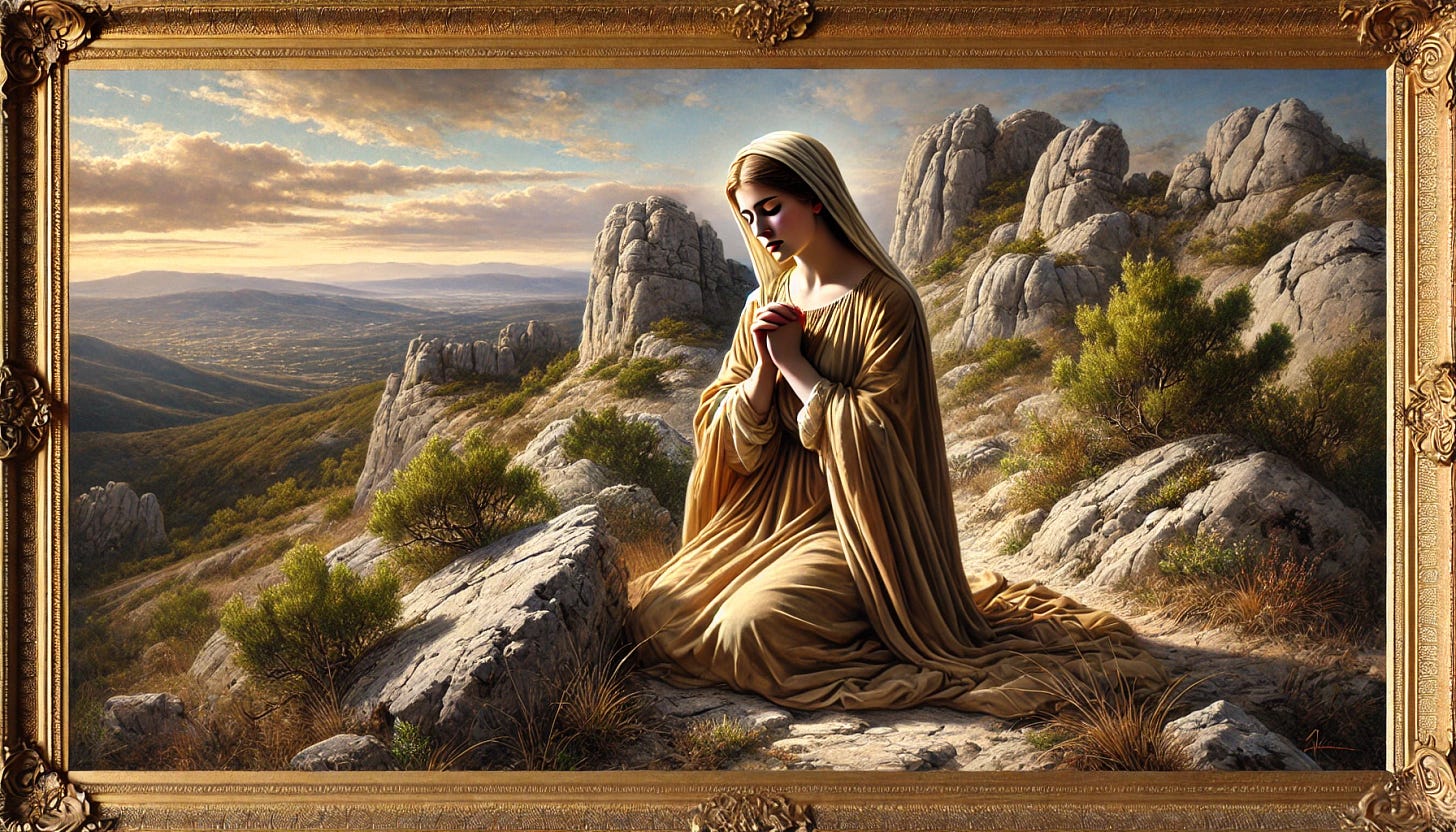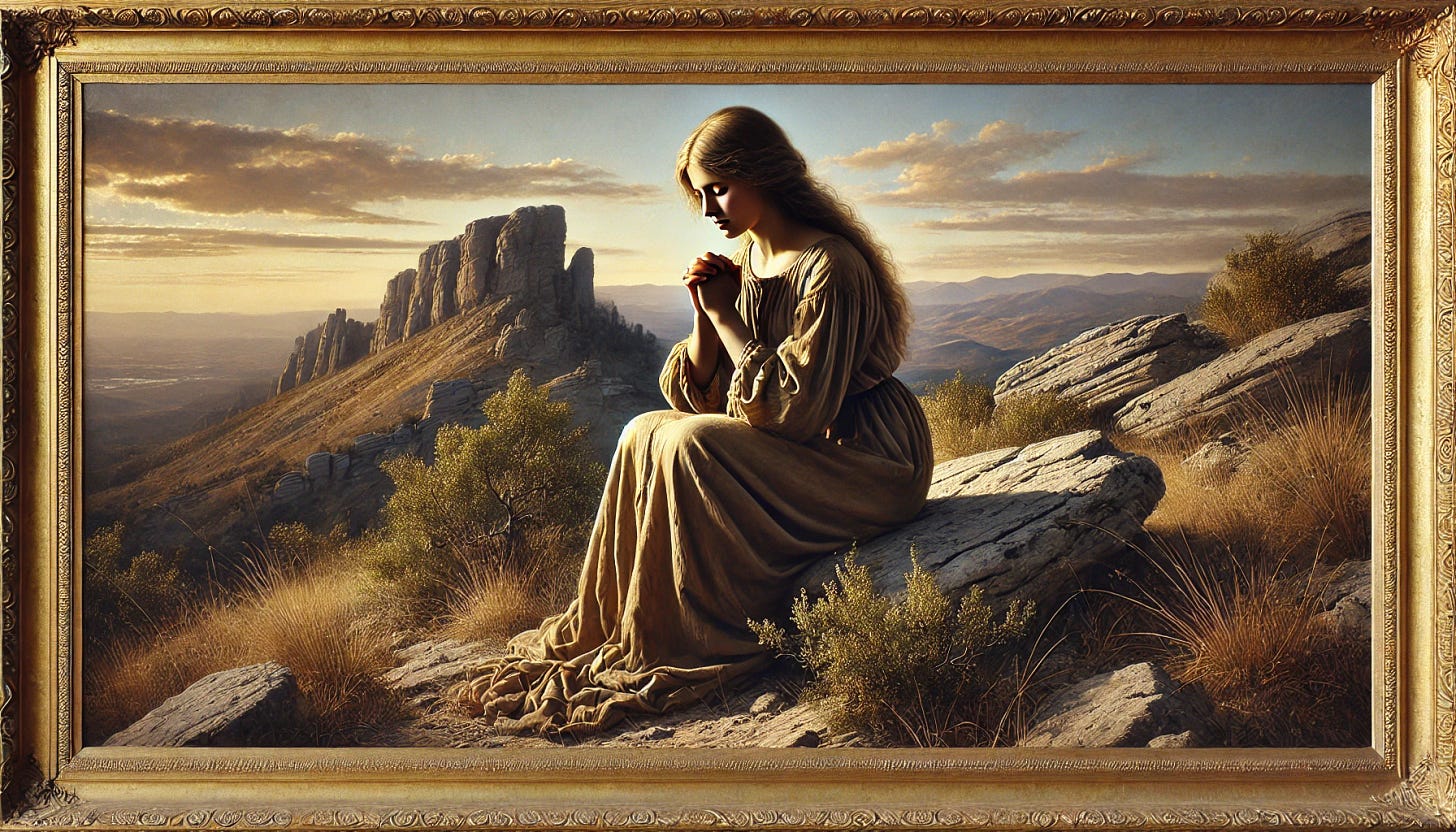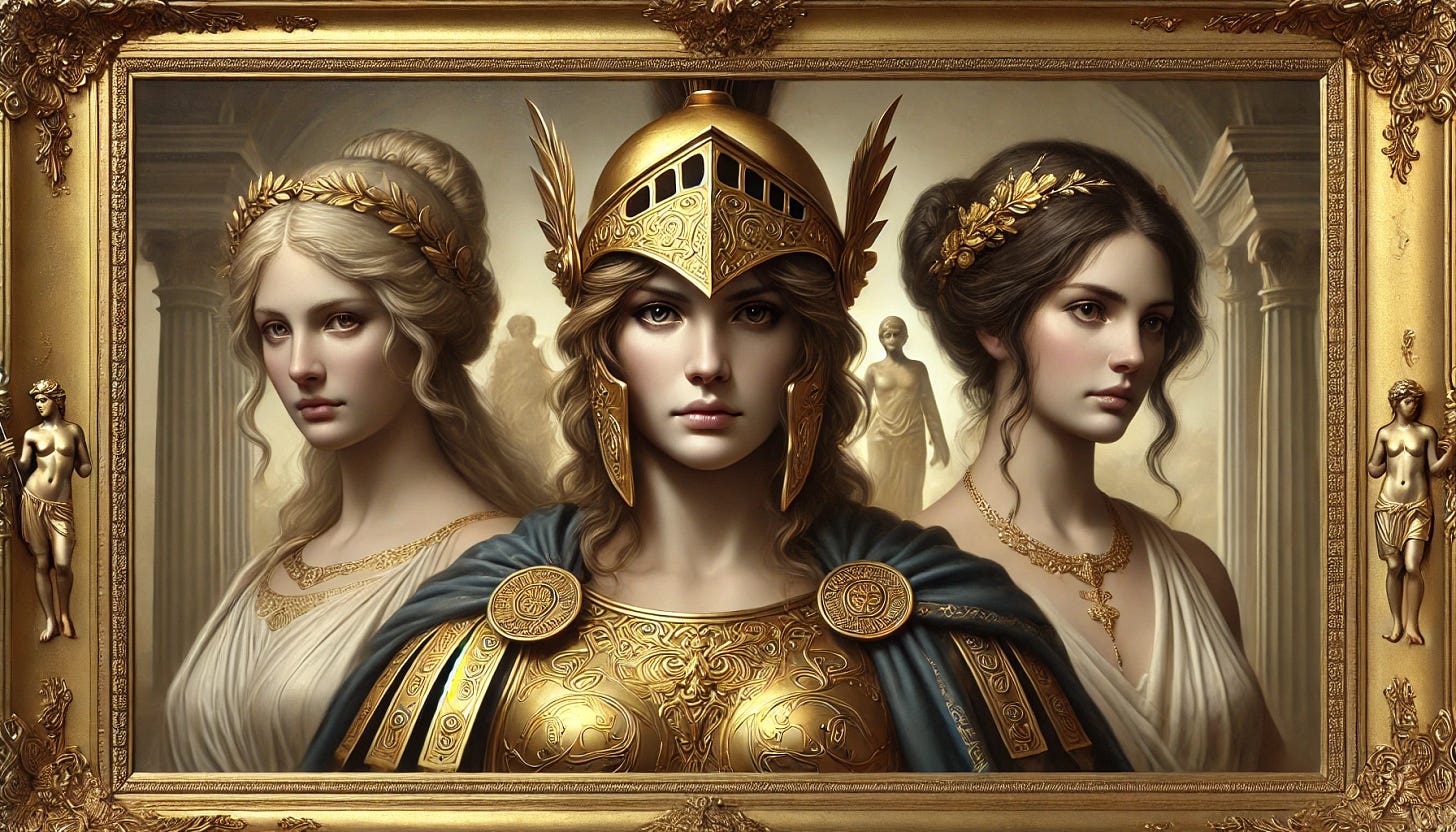Magdalene-Chalice of the Far Shore of The Sky-Veil
A reflection on transformation in Christ through The Sky-Veil.
Important Companion Reads
The Sky-Veil
The Sky-Veil is a mythopoetic journey through a forgotten realm where the divine brushes the mortal. This is a journey of longing, wisdom, and the quiet majesty that crowns the soul.
The journey across the Sky-Veil is one of transformation in Christ through the Immaculate Heart of Mary—from enchantment to sanctification, from longing to love, from symbol to sacrament, from myth to the mystery of eternal life in the Blessed Trinity.

The Preparation of the Greek World
Philosophy and Mythology as the schoolmaster of the Greek mind
In the beginning, the world was given signs and figures—shadows cast before the fullness of time. To the Hebrews God gave the Law and the Prophets. To the pagan Greeks he gave philosophy and, we might project, the mythology informing it.
"Perchance, too, philosophy was given to the Greeks directly and primarily, till the Lord should call the Greeks. For this was a schoolmaster to bring 'the Hellenic mind,' as the Law, the Hebrews, 'to Christ.' Philosophy, therefore, was a preparation, paving the way for him who is perfected in Christ." ~ St. Clement of Alexandria, Stromata (150-215 AD), Book VI, Chapter 8
Greek mythology was the ground from which their philosophy emerged. Pre-Socratic mythology was the shimmering “silent Being” out of which post-Socratic Greek metaphysics emerged. Thus, mythology, as an unfolding foreshadowing of the true faith, can be considered that soil given by God to nurture the development of the pagan mind, preparing them to receive the light of Christ.
"The very thing which is now called the Christian religion existed among the ancients also, nor was it wanting from the inception of the human race until the coming of Christ in the flesh, at which point the true religion which was already in existence began to be called Christian." ~ St. Augustine (354-430 AD), Retractions, Book I, Chapter 13
We might, then, surmise that the true religion was hidden beneath the yearnings of the ancient Greeks of the Iliad and the Odyssey. It germinated in the liminal spaces where gods and goddesses walked among men on the battlefields and over long journeys at sea. It emerged in alethic majesty to be called Christian when the Church collided with the Greco-Roman world after her birth by the Holy Spirit at Pentecost.
“Therefore I say to you, that the kingdom of God shall be taken from you, and shall be given to a nation yielding the fruits thereof.” ~ Matthew 21: 43
Athena, Hera, and Aphrodite, the three key mythological figures founding western civilization—from the judgement of Paris leading to the Trojan War—shimmered in a Greek world emerging over centuries as “Christian.” They disappeared as ‘entities’ to be worshipped and remained ‘qua themselves’ heralds and harbingers of the Faith to come, alerting our attention to a world beyond and foreshadowing the light of Christ.

Athena, Hera, Aphrodite—the Harbingers of Being
Athena, in the pagan Greek unfolding, stood in the liminal space with spear and shield, the light of the mind in battle and in civic order. She guarded wisdom, summoned strategy, and forged civilization from chaos. But her light, though sparkling as herald, could not yet pierce the veil.
Hera, in the Greek unfolding, sat enthroned in might, bearing the power of majesty. Her nearness as harbinger of Being ruled the liminal veil by silent word and by what must not be shaken. She was order behind order, the crown above crowns—but her pagan throne remained untouched by tears of repentance, unmoved by tombs of resurrection beyond the veil.
Aphrodite, in this unfolding, stirred the hearts of gods and mortals alike, the longing for love’s embrace, the ache of beauty calling us home. She was the shimmer of love and beauty at the threshold, but never the voice that answered:
“Sir, if thou hast taken him hence, tell me where thou hast laid him, and I will take him away.” (John 20:15)
What the ancients could not see beyond the veil was that Athena was not a goddess but the “grey-eyed” threshold alerting their attention to wisdom, philosophy, strategy, and creativity. Hera was the “ox-eyed” threshold of majesty and hierarchical order in the world. Aphrodite was the “laughter-loving” threshold of divine love, beauty, harmony, and joy. The ‘goddesses’ were not in the imagination of subjective consciousness, nor were they real entities. They were heralds of Being, lights in the liminal world alerting pagans to veiled grace on the other side.
In the modern post-metaphysical world, they are the enchanting shimmers drawing our attention back to the inceptual soil—to wisdom, majesty, beauty, and love ‘in the world’—neither ancient goddesses nor subjective acts of post-modern imagination. Dawn ‘spreads her rosy fingers’ across the sky ‘in the world’ not in our imagination. Athena, Hera, and Aphrodite are not goddesses; they are glittering, enchanting thresholds, drawing us across the veil to God in a world once again devoid of metaphysical flame.
Athena points us to wisdom beyond the veil. Hera points us to majesty and divine order. Aphrodite points us to beauty and love in longing.

The Hebrew World
Mary Magdalene
Emerging from the Hebrew world of divine revelation, pointing to the world beyond the veil pagans could not pierce, we have—Magdalene. A woman not draped in myth, but veiled in tears of repentance, radiating love. She stood where pagan goddesses could not tread: at the foot of the cross and before the mouth of the tomb, where love and death had met.
She did not carry weapons. She did not wear a crown. She did not command hearts. She simply sat at the Master’s feet and anointed him with perfumed oils.
And because of her contrition, she ‘saw’ with the inceptual mind of Aletheia—truth revealed, not deduced. Magdalene ‘saw’ Christ for who he was as she journeyed by his side during his ministry, listened at his feet, wept at the foot of his cross, and heard him speak her name at his tomb. Where the harbingers only heralded, she crossed over. On our earthly sojourn as pilgrims hoping to cross over with Magdalene, we experience the enchantment of the heralds, Athena, Hera, and Aphrodite as they alert us to the world beyond the veil.
Magdalene Fulfilled
If Athena is the shimmering enchantment of the light of the mind in the world, Magdalene is the light of recognition.
If Hera is the shimmering enchantment of majesty, Magdalene is the presence of love enthroned.
If Aphrodite is the shimmering enchantment of divine love and beauty, Magdalene is the encounter with love fulfilled.
Magdalene is the one who heard her name, “Mary!” and turned to cross where the harbingers only heralded—toward the Word made flesh, the Voice who called her into Being.
Enjoy “The Second Wind” with Mary Magdalene. Lyrics ©Walter Emerson Adams. Music and vocals by Suno (©Walter Emerson Adams). Purchase the album, The House of New Bethany here.
Also, “The Dawn of the Three” with Athena, Hera, and Aphrodite. Lyrics ©Walter Emerson Adams. Music and vocals by Suno (©Walter Emerson Adams). Purchase the album, Mythic Revelations here.



